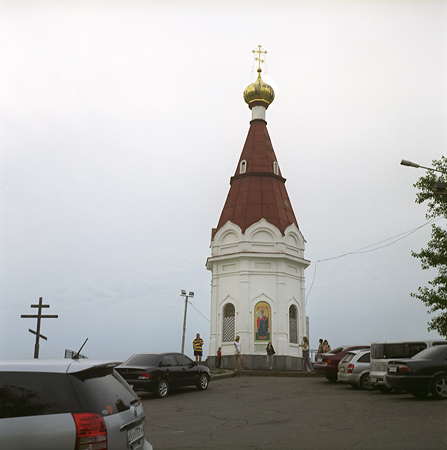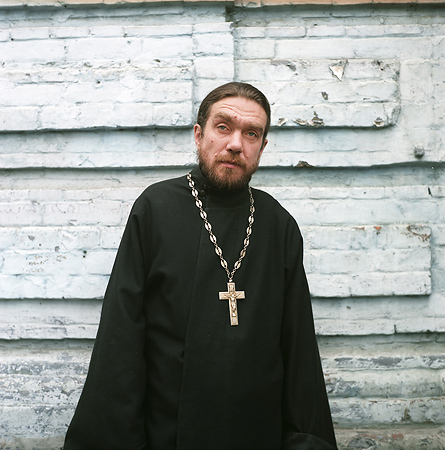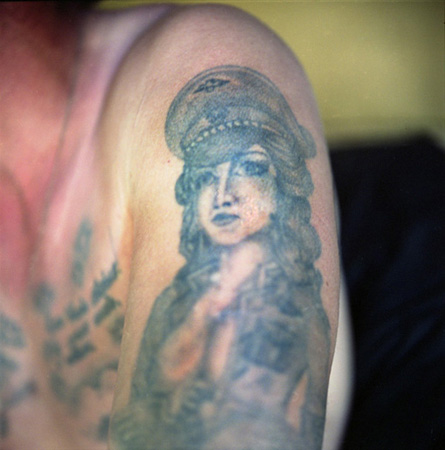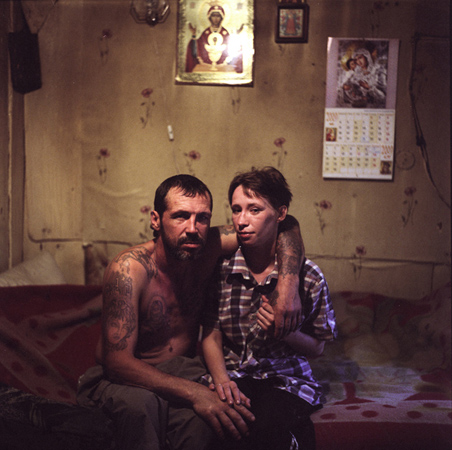
“Better be jailed than saint”
All content © 2009 - 2024 Max Sher. Site by
AlT. Powered by
zenPHOTO

At the turn of the 20th century, Nikolaevka was a working class suburb of Krasnoyarsk. Today it is densely inhabited by those with a criminal past and present. The Trans-Siberian railway and a concrete wall built along its right of way separate this ghetto of sorts from downtown Krasnoyarsk.
All content © 2009 - 2024 Max Sher. Site by
AlT. Powered by
zenPHOTO

Zhenya, a resident of Nikolayevka. Zhenya’s mother who has two more children, works as a cleaner for the railway and lives with a hard-core criminal who was recently released from jail.
All content © 2009 - 2024 Max Sher. Site by
AlT. Powered by
zenPHOTO

Andrei Perets, owner of a malina – a hideout where those released from jail may come and live for a while deciding what to do or where to go.
All content © 2009 - 2024 Max Sher. Site by
AlT. Powered by
zenPHOTO

This Orthodox chapel on the Watch Hill overlooking Krasnoyarsk is well known to all Russians because it features on the 10-ruble notes, thus making it a symbol of money rather than faith.
All content © 2009 - 2024 Max Sher. Site by
AlT. Powered by
zenPHOTO

Eduard, a hard-core criminal and a tatooer. He spent more than a half of his 39 years behind bars.
All content © 2009 - 2024 Max Sher. Site by
AlT. Powered by
zenPHOTO

The high security prison #6 is located in the middle of a residential neighbourhood in Krasnoyarsk. When the Soviet Union was approaching its demise in October 1991, a large-scale mutiny took place here with hostage-taking and victims. The inmates held power for more than a month having seized weapons from the guards. From this mutiny, a whole wave of prison upheavals has begun, sweeping over the country at the end of the USSR.
All content © 2009 - 2024 Max Sher. Site by
AlT. Powered by
zenPHOTO

An icon of Christ in Andrei Perets’ home.
All content © 2009 - 2024 Max Sher. Site by
AlT. Powered by
zenPHOTO

Father Valery Soldatov once chaired a diocesan department in charge of prisons. Andrei Perets worked for him in his church as a sacristan and even wore a cassock. Then their paths diverged. Father Valery believes hard-core criminals are practically impossible to rectify. ‘Maybe someone succeeded in it but not me”, - he says.
All content © 2009 - 2024 Max Sher. Site by
AlT. Powered by
zenPHOTO

A tomb of a Gypsy headman
All content © 2009 - 2024 Max Sher. Site by
AlT. Powered by
zenPHOTO

Station square in Krasnoyarsk. Railway stations have always been a magnet for petty criminals. Those traveling along the Trans-Siberian Railway may be offered “drugs” – the so-called “hashish” which in fact is a mix of dried chewing gum, ash and tobacco.
All content © 2009 - 2024 Max Sher. Site by
AlT. Powered by
zenPHOTO

A tattoo depicting a woman in a Nazi cap showing off her breasts.
During Soviet times, tattooed Nazi symbols were very popular among
criminals as they symbolised their resistance against the "system".
All content © 2009 - 2024 Max Sher. Site by
AlT. Powered by
zenPHOTO

River Yenisei near Krasnoyarsk. During Soviet times, it saw thousands of prisoner transports taking convicts up north to Norilsk and other Arctic parts of the GULAG archipelago.
All content © 2009 - 2024 Max Sher. Site by
AlT. Powered by
zenPHOTO

Sasha Gromadsky, 41, took part in the mutiny that broke out at high security prison #6 in Krasnoyarsk in October 1991. Gromadsky is not his family name but a nickname: he served one of his terms in a remote Siberian village of Gromadsk.
All content © 2009 - 2024 Max Sher. Site by
AlT. Powered by
zenPHOTO

Graffiti in central Krasnoyarsk.
All content © 2009 - 2024 Max Sher. Site by
AlT. Powered by
zenPHOTO

Those recently released from jail may come to Andrei Perets'
hideout in Nikolaevka and live for a while deciding what to do and
where to go.
All content © 2009 - 2024 Max Sher. Site by
AlT. Powered by
zenPHOTO

All content © 2009 - 2024 Max Sher. Site by
AlT. Powered by
zenPHOTO

A criminal tatooer’s hand.
All content © 2009 - 2024 Max Sher. Site by
AlT. Powered by
zenPHOTO

Simple living at Andrei's hideout
All content © 2009 - 2024 Max Sher. Site by
AlT. Powered by
zenPHOTO

A tattooed star on the knee means "Will never get down on my knees
before a cop".
All content © 2009 - 2024 Max Sher. Site by
AlT. Powered by
zenPHOTO

A motto tattooed on Andrei's feet that may loosely be translated as
“You never get a blowjob from a cop, you never escape from
Krasnoyarsk Gulag”.
All content © 2009 - 2024 Max Sher. Site by
AlT. Powered by
zenPHOTO

Andrei Perets with his girlfriend Valentina aka Valentos.
All content © 2009 - 2024 Max Sher. Site by
AlT. Powered by
zenPHOTO

A man poses for picture in a T-shirt with the logo of a local radio station that broadcasts criminal songs - the so-called shanson.
All content © 2009 - 2024 Max Sher. Site by
AlT. Powered by
zenPHOTO

Badalyk Cemetery in Krasnoyarsk where many criminal bosses and fighters killed during the mid-1990s mafia wars are buried.
All content © 2009 - 2024 Max Sher. Site by
AlT. Powered by
zenPHOTO



















